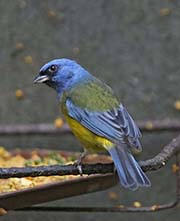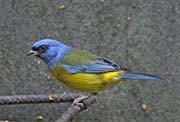Blue-and-yellow Tanager - Thraupis bonariensis
| Length | |
| Weight | |
| Clutch Size | |
| Chicks at birth | |
| IUCN Conservation Status | |
Continents: |
The Blue-and-yellow Tanager has four subspecies and is found in South America. The sexes are dimorphic with the male being more colorful. The male has a black mask and the rest of the head is light blue. The underparts are yellow-orange, the wings and tail are blue, the back is either black or olive green depending on the subspecies and the wings and tail are light blue. The female is duller and lighter in coloration and is mostly grayish-brown, with a dusky blue tinge on the head and a yellowish-buff rump.
Diet: Forages for fruit (including cultivated fruit), leaves, buds, flowers and insects in low vegetation (including tree tops). Will peck pieces out of larger fruit and is considered destructive to orchards and gardens.
Courtship: Blue-and-yellow Tanagers live in pairs, singly or in small groups of 3-4 birds. No information was found on their courtship behavior.
Nesting: The cup-shaped nest is usually built in the crown of a small tree or bush. The female lays 2-4 eggs and their color varies between nests and within the same nest. They can be dirty white, pale blue, or pale green. Both parents feed the young.
Habitat and Range: Blue-and-yellow Tanagers are found in Argentina, Uruguay, Brazil, Paraguay, Bolivia, northern Chile and Andean Peru and Ecuador. They inhabit trees and shrubbery in open woodland and semi-open areas such as scrubby hillsides, savannas, parks, gardens, cultivated lands, etc.
Vocalization: Blue-and-yellow Tanagers are considered noisy birds. Their song is a series of four to six sweet, doubled notes, 'swee-sur, swee-sur, swee-sur'.
Plumage/Molt No alternate plumage.
Migration: Blue-and-yellow Tanagers that live in the southern regions migration northeast during their winter.
Tongue/feet: Grayish legs and feet.
Bibliography:
- http://en.wikipedia.org The Free Encyclopedia, Accessed December, 2012
- http://arkive.org Arkive: Images of life on earth, Accessed December, 2012
- Isler, Morton L. and Isler, Phyllis R., The Tanagers: Natural History, distribution, and Identification,Smithsonian Institution Press, Washington D.C., 1987
- Ridgely, Roberts S. and Tudor, Guy, Field Guide to the Songbirds of South America: The Passerines,University of Texas Press, 2009





